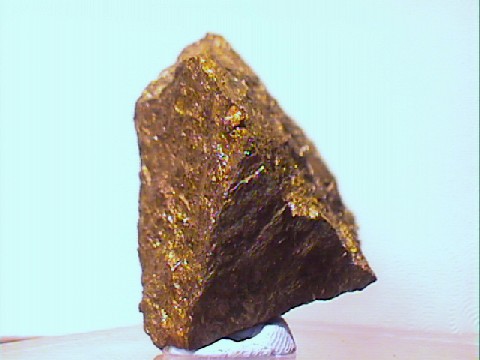 THE
MINERAL PENTLANDITE
THE
MINERAL PENTLANDITE
- Chemistry: (Fe, Ni)9S8, Iron Nickel Sulfide.
- Class: Sulfides
- Group: Pentlandite
- Uses: As the principle ore of nickel, a minor ore of iron and as mineral specimens.
Specimens
Pentlandite is an important ore of nickel. However, it does not produce good crystals and is generally only found in massive form. It is commonly associated with other sulfides such as pyrite, chalcopyrite and pyrrhotite in basic igneous rock intrusions. These sulfide ore bodies are probably produced through magmatic segregation. As the hot liquid of the magma cools, crystals of high-density minerals such as metal sulfides fall to the bottom of the magma chamber and collect into one large metal-rich bonanza for mining companies.
Pentlandite's close association with the mineral pyrrhotite (Fe1-xS) is believed to be the result of exsolution that occurs after magmatic segregation. At higher temperatures and pressures, the chemicals that make up the two minerals are compatible in a more or less semi-solid form. But as the temperature and pressure lower, the two chemistries become incompatible and they separate into two different minerals. The two are difficult to differentiate when pyrrhotite is in a massive form. Both are brassy yellow, dense and metallic with a hardness around 4 and a similar streak. Pyrrhotite is usually magnetic, although weakly so, and lacks the octahedral parting of pentlandite which provides the only good field tests for differentiation. But the two are so often and intimately associated that if you have a sample of pentlandite, you can be assured that you also have pyrrhotite!
Pentlandite's formula is believed to be composed of equal amounts of nickel and iron, but does show variation in tests, probably as a result of pyrrhotite inclusions in test samples. The structure of pentlandite is rather complex, with a face centered cubic arrangement and the metal ions in tetrahedral and octahedral coordination with the sulfurs. Coordination refers to the number and position of the sulfurs surrounding the metal ions. In the case of tetrahedral coordination, there are four sulfurs surrounding one metal ion and they are positioned at the four points of a tetrahedron. In the case of octahedral coordination, there are six sulfurs at the six points of an octahedron with a metal ion inside.
Pentlandite lends its name and structure to a group of minerals called the Pentlandite Group. It is a group of rather rare minerals, save for pentlandite, that all have the same structure and somewhat similar chemistries. The general formula is AB8(S, Se)8 where silver, manganese, cadmium or lead can be found in the A position. While the B position can be occupied by copper. More versatile metals such as iron, nickel and cobalt can occupy either the A or B positions.
These are the members of the Pentlandite Group:
Argentopentlandite (Silver Iron Nickel Sulfide)Cobalt pentlandite (Cobalt Iron Nickel Sulfide)Geffroyite (Copper Iron Silver Lead Selenide Sulfide)Manganese-shadlunite (Iron Copper Manganese Lead Sulfide)- Pentlandite (Iron Nickel Sulfide)
Shadlunite (Iron Copper Lead Cadmium Sulfide)
PHYSICAL CHARACTERISTICS OF PENTLANDITE:
- Color is muted brassy to bronze yellow.
- Luster is metallic.
- Transparency crystals are opaque.
- Crystal System is isometric; 4/m bar 3 2/m
- Crystal Habits are limited to mostly massive rock forming formations and as granular components of massive sulfide rocks.
- Hardness is 3.5 - 4
- Specific Gravity is approximately 4.6 - 5.0 (average for metallic minerals)
- Streak is light brown to light bronze.
- Other Characteristics: Octahedral parting is generally evident as odd cracks or fractures in the massive material and the lack of any magnetism helps differentiate it from the similar and often associated pyrrhotite.
- Associated Minerals include pyrrhotite,
niccolite , biotite, millerite, pyrite and chalcopyrite - Notable Occurrences include a large deposit at Sudbury, Ontario and smaller deposits at Lynn Lake and Moak Lake, Manitoba and Malartic, Quebec, Canada; Ducktown, Tennessee and San Diego County, California, USA; Russia; Bushveld, Transvaal, South Africa and Lillehammer, Norway.
- Best Field Indicators are parting, associations, lack of magnetism, streak and color.


